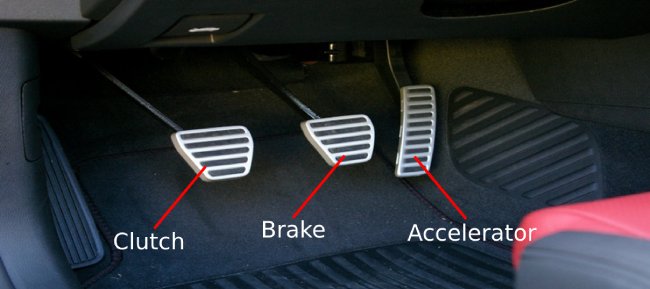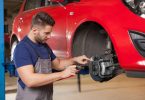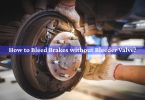Learning what the pedals do and their position is a must for anyone learning to drive. Using the brake correctly is essential to avoiding accidents.
Here we’ll show which pedal is the brake in an automatic car, the how-to brake, and offer helpful advice on braking.
Identifying the car pedals

When you are looking at your feet, the brake pedal will be on your left, and the accelerator or gas pedal will be on your right. You will need to use one foot to control the pedals when driving.
Which Pedal Is the Brake in an Automatic Car?
The brake pedal is on the left (see illustration above). You need to keep your heel on the floor and press the brake with consistent force when braking. Braking too hard will cause the car to stop suddenly and throw you and your passengers forward. Braking too soft will take too long to stop and cause an accident. Firm controlled stopping is the best way.
Keeping your heel on the floor when pressing the brake helps you control how firmly you brake and lets you pivot your foot to the gas pedal; when you start to drive forward after stopping.
You must be sure to give yourself enough time to brake, or you could cause an accident. Braking is a practiced skill that improves over time. Before you start driving, go to an empty parking lot and practice driving to get the hang of it. Don’t get discouraged – everyone has to practice braking as they learn to drive!
Do you need both feet to drive an automatic car?
No. It is best to use only one foot. Using two feet makes it hard to control the pedals. When you are learning to drive, using two feet makes it more confusing and could result in an accident.
How to Use the Brake Pedal in an Automatic Car?
The brake pedal slows the car down when going too fast and stops the vehicle at a stoplight or sign. When used correctly, it keeps the car’s occupants safe. When you misuse the brake, it can be disastrous.
Are the foot pedals the same in all cars?
Yes, the pedals are in the same place in all cars. Whether you drive a vehicle in the U.S. or Europe, the pedal placement remains the same. Only the steering wheel changes position.
How come the brake pedal is higher than the accelerator?
The height difference ensures you are stepping on the brake and not the gas. If the pedals were the same height, it would be easier to step on the accelerator accidentally. Despite the height difference, there are still people that make that mistake.
Do you use the brake pedal the same as in an American car in the UK?
Car pedal placement is universal. No matter the car or the country, the brake and the accelerator are in the same position.
Why are there 3 pedals in some automatic cars?

Automatic cars usually only have two pedals. In some vehicles, the third pedal on the left of the brake is a dead pedal or somewhere to put your left foot.
The third pedal is the clutch used when manually shifting the gears in a manual car. The gears shift automatically as you press the pedals in an automatic car.
What makes the brakes slip?
A slipping brake is usually one of three problems. The master cylinder or the brakes are glazed. When it is the master cylinder, there is a seal leaking and the reduction in fluid makes the brake harder to press. As a result, it takes longer to stop.
When the brakes glaze, they are so hot they create friction and cause the glazing. Frequent hard braking or slamming the foot on the brake to stop on a dime often cause glazing.
If your brake calipers stick, this will also overheat the brakes and cause slipping.
What do rear brakes do?
Rear brakes offer stability. Most cars today have disc brakes on the front and back. Rear disc brakes are also required to have an emergency or parking brake. It must be separate so if your brakes fail, you have another way to stop the car.
Can you start an automatic car without pressing the brake?
It is a good idea to press on the brake when starting a car, though it isn’t really necessary with most cars today. Today’s automobiles have a safety feature called shift lock that allows the vehicle to start in park or neutral, but you can’t engage the gear shift without pressing the gas pedal first.
Why is the brake pedal bigger in an automatic car?
The pedal is larger for two reasons: one, so it is easier to find and use in an emergency, and two, the width also lets you use your left foot, a lifesaver for someone who drives with two feet.
Tips for better braking
- Place your right foot with the heel on the floor, lined up with half the brake pedal
- Press the brake firmly in one fluid motion
- Start braking 20 feet before you reach a stop sign or light
- Press the firewall with your left foot for stability
- Reduce your speed to reduce stopping time in hazardous areas by taking your foot off the accelerator
- Scan the area where you will stop for potential dangers
- Learn to anticipate the actions of other drivers to aid in a quick response
- Keep your brakes well maintained to work when you need to use them
- Don’t wait to take the car to a mechanic when the brakes are not working correctly or the brake light comes on
- Leave two car lengths between you and the driver in front of you for emergency braking
- Make sure your brake lights are working so the person behind you knows when you are stopping










Leave a Comment